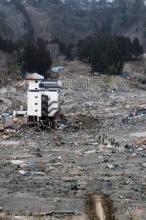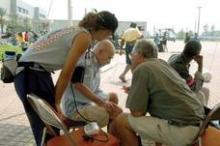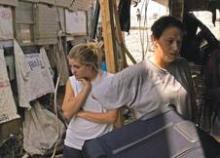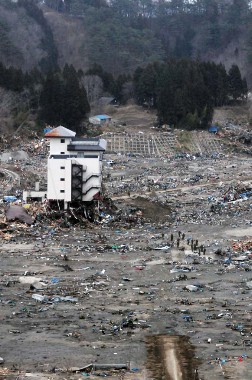User login
Hurricanes, earthquakes and other natural disasters cause long-term changes in cardiovascular risk, new data show. Physicians probably should be thinking about how to monitor or even counter these increased risks, according to several speakers at the annual meeting of the American College of Cardiology in San Francisco.
Since Hurricane Katrina hit New Orleans in 2005, the proportion of patients admitted to Tulane Medical Center who were hospitalized because of myocardial infarction more than tripled and has stayed high for a surprising 6 years (so far), one retrospective study of 69,337 patients found. And New Orleans residents started having more heart attacks at night and on weekends instead of the usual pattern of increased MI rates on weekday mornings, especially Mondays, a separate retrospective study showed. A world away, in Japan, the MI rate jumped not only after the massive earthquake in 2011 but also after seismically intense shocks before or after the big one, a third study found.
There’s not much we can do to prevent natural disasters, but can we do something about the cardiac consequences? "The impact is inevitable if we don’t intervene prophylactically," Tulane’s Dr. Anand M. Irimpen said at a press conference featuring these studies.
He and his associates found that the incidence of MI in patients being admitted to the hospital increased from 0.7% in the 2 years preceding Hurricane Katrina to 2.4% in the 6 years after Katrina (P less than .0001). Patients post Katrina were significantly more likely to have known coronary artery disease, a prior coronary artery bypass graft, hyperlipidemia, psychiatric comorbidities, and substance abuse; and to be smokers, unemployed, and uninsured, compared with pre-hurricane patients. Prescriptions for aspirin, beta-blockers, statins, ACE inhibitors, and angiotensin receptor blockers were more likely for post-Katrina patients, but they were less likely to adhere to therapy, compared with pre-hurricane patients (52% vs. 71%, respectively; P less than .0001).
"The fact that this persisted for 6 years speaks volumes" about the far-reaching, long-term destruction caused by the hurricane, he said.
Often, the idea of rebuilding homes gets the most attention after a natural disaster, but maybe rebuilding things like pharmacies or fitness centers should get more attention, he added. Mobile pharmacies might help patients adhere to therapy in the meantime. And clinicians should pay close attention to patients’ stress and anxiety levels long after a disaster, Dr. Irimpen said.
The shift away from weekday morning heart attacks to night and weekend MIs, and the persistence of this pattern, "shows that stress played a big role" and even outweighed some other factors, said Tulane’s Dr. Matthew Peters.
The study of data on 299 MIs before Katrina, 408 in the first 3 years after, and 337 in years 4 and 5 after the hurricane, showed that 44% of heart attacks in years 4 and 5 happened on weekends after Katrina, compared with 30% before. The proportion of weekday heart attacks decreased from 60% before Katrina to 36% in years 4 and 5, and the proportion of morning MIs decreased from 45% to 31%.
The influx of heart attacks in the off-hours of nights and weekends has practical implications. Fewer medical staff are available, and other data suggest that MI patients treated at night are more likely to fail angioplasty, have longer door-to-balloon times, and develop complications in the hospital, he said.
The Japanese study also suggested that stress trumped the usual circadian pattern of heart attacks and the environmental destruction caused by the March 11, 2011 earthquake and tsunami. The intensity of the earth’s shaking – even in pre-shocks leading up to the big one and aftershocks – corresponded with increases in heart attacks, Dr. Motoyuki Nakamura and his associates reported.
They analyzed data for 53 patients in Japan’s Iwate Prefecture who suffered MI or sudden death in the 4 weeks leading up to the big earthquake and 8 weeks after, and compared those with 30 cases of MI or sudden death in the same weeks of 2009 and 2010 in the same geographical area. In 2011, the incidence of MI or sudden death rose and fell according to the seismic intensity of earth shocks and was nearly twice as high as in the previous years.
Preventive measures in earthquake-prone areas should be considered, such as public availability of automated external defibrillators and advanced hospital disaster planning, suggested Dr. Nakamura, professor of medicine at Iwate (Japan) Medical University. Clinicians should keep a supply of medications on hand to help prevent MI in high-risk patients, such as quick-acting calcium channel blockers, beta-blockers, aspirin, and sublingual nitroglycerin, he added.
The cardiac effects of natural disasters can be felt long after a hurricane dies or the ground stops shaking. Pictures of the destruction may feel heartbreaking, but it’s clear that these disasters really do break hearts.
Dr. Nakamura’s study was funded in part by the Takeda Science Foundation. Dr. Irimpen, Dr. Peters, and Dr. Nakamura reported having no financial disclosures.
–By Sherry Boschert
Hurricanes, earthquakes and other natural disasters cause long-term changes in cardiovascular risk, new data show. Physicians probably should be thinking about how to monitor or even counter these increased risks, according to several speakers at the annual meeting of the American College of Cardiology in San Francisco.
Since Hurricane Katrina hit New Orleans in 2005, the proportion of patients admitted to Tulane Medical Center who were hospitalized because of myocardial infarction more than tripled and has stayed high for a surprising 6 years (so far), one retrospective study of 69,337 patients found. And New Orleans residents started having more heart attacks at night and on weekends instead of the usual pattern of increased MI rates on weekday mornings, especially Mondays, a separate retrospective study showed. A world away, in Japan, the MI rate jumped not only after the massive earthquake in 2011 but also after seismically intense shocks before or after the big one, a third study found.
There’s not much we can do to prevent natural disasters, but can we do something about the cardiac consequences? "The impact is inevitable if we don’t intervene prophylactically," Tulane’s Dr. Anand M. Irimpen said at a press conference featuring these studies.
He and his associates found that the incidence of MI in patients being admitted to the hospital increased from 0.7% in the 2 years preceding Hurricane Katrina to 2.4% in the 6 years after Katrina (P less than .0001). Patients post Katrina were significantly more likely to have known coronary artery disease, a prior coronary artery bypass graft, hyperlipidemia, psychiatric comorbidities, and substance abuse; and to be smokers, unemployed, and uninsured, compared with pre-hurricane patients. Prescriptions for aspirin, beta-blockers, statins, ACE inhibitors, and angiotensin receptor blockers were more likely for post-Katrina patients, but they were less likely to adhere to therapy, compared with pre-hurricane patients (52% vs. 71%, respectively; P less than .0001).
"The fact that this persisted for 6 years speaks volumes" about the far-reaching, long-term destruction caused by the hurricane, he said.
Often, the idea of rebuilding homes gets the most attention after a natural disaster, but maybe rebuilding things like pharmacies or fitness centers should get more attention, he added. Mobile pharmacies might help patients adhere to therapy in the meantime. And clinicians should pay close attention to patients’ stress and anxiety levels long after a disaster, Dr. Irimpen said.
The shift away from weekday morning heart attacks to night and weekend MIs, and the persistence of this pattern, "shows that stress played a big role" and even outweighed some other factors, said Tulane’s Dr. Matthew Peters.
The study of data on 299 MIs before Katrina, 408 in the first 3 years after, and 337 in years 4 and 5 after the hurricane, showed that 44% of heart attacks in years 4 and 5 happened on weekends after Katrina, compared with 30% before. The proportion of weekday heart attacks decreased from 60% before Katrina to 36% in years 4 and 5, and the proportion of morning MIs decreased from 45% to 31%.
The influx of heart attacks in the off-hours of nights and weekends has practical implications. Fewer medical staff are available, and other data suggest that MI patients treated at night are more likely to fail angioplasty, have longer door-to-balloon times, and develop complications in the hospital, he said.
The Japanese study also suggested that stress trumped the usual circadian pattern of heart attacks and the environmental destruction caused by the March 11, 2011 earthquake and tsunami. The intensity of the earth’s shaking – even in pre-shocks leading up to the big one and aftershocks – corresponded with increases in heart attacks, Dr. Motoyuki Nakamura and his associates reported.
They analyzed data for 53 patients in Japan’s Iwate Prefecture who suffered MI or sudden death in the 4 weeks leading up to the big earthquake and 8 weeks after, and compared those with 30 cases of MI or sudden death in the same weeks of 2009 and 2010 in the same geographical area. In 2011, the incidence of MI or sudden death rose and fell according to the seismic intensity of earth shocks and was nearly twice as high as in the previous years.
Preventive measures in earthquake-prone areas should be considered, such as public availability of automated external defibrillators and advanced hospital disaster planning, suggested Dr. Nakamura, professor of medicine at Iwate (Japan) Medical University. Clinicians should keep a supply of medications on hand to help prevent MI in high-risk patients, such as quick-acting calcium channel blockers, beta-blockers, aspirin, and sublingual nitroglycerin, he added.
The cardiac effects of natural disasters can be felt long after a hurricane dies or the ground stops shaking. Pictures of the destruction may feel heartbreaking, but it’s clear that these disasters really do break hearts.
Dr. Nakamura’s study was funded in part by the Takeda Science Foundation. Dr. Irimpen, Dr. Peters, and Dr. Nakamura reported having no financial disclosures.
–By Sherry Boschert
Hurricanes, earthquakes and other natural disasters cause long-term changes in cardiovascular risk, new data show. Physicians probably should be thinking about how to monitor or even counter these increased risks, according to several speakers at the annual meeting of the American College of Cardiology in San Francisco.
Since Hurricane Katrina hit New Orleans in 2005, the proportion of patients admitted to Tulane Medical Center who were hospitalized because of myocardial infarction more than tripled and has stayed high for a surprising 6 years (so far), one retrospective study of 69,337 patients found. And New Orleans residents started having more heart attacks at night and on weekends instead of the usual pattern of increased MI rates on weekday mornings, especially Mondays, a separate retrospective study showed. A world away, in Japan, the MI rate jumped not only after the massive earthquake in 2011 but also after seismically intense shocks before or after the big one, a third study found.
There’s not much we can do to prevent natural disasters, but can we do something about the cardiac consequences? "The impact is inevitable if we don’t intervene prophylactically," Tulane’s Dr. Anand M. Irimpen said at a press conference featuring these studies.
He and his associates found that the incidence of MI in patients being admitted to the hospital increased from 0.7% in the 2 years preceding Hurricane Katrina to 2.4% in the 6 years after Katrina (P less than .0001). Patients post Katrina were significantly more likely to have known coronary artery disease, a prior coronary artery bypass graft, hyperlipidemia, psychiatric comorbidities, and substance abuse; and to be smokers, unemployed, and uninsured, compared with pre-hurricane patients. Prescriptions for aspirin, beta-blockers, statins, ACE inhibitors, and angiotensin receptor blockers were more likely for post-Katrina patients, but they were less likely to adhere to therapy, compared with pre-hurricane patients (52% vs. 71%, respectively; P less than .0001).
"The fact that this persisted for 6 years speaks volumes" about the far-reaching, long-term destruction caused by the hurricane, he said.
Often, the idea of rebuilding homes gets the most attention after a natural disaster, but maybe rebuilding things like pharmacies or fitness centers should get more attention, he added. Mobile pharmacies might help patients adhere to therapy in the meantime. And clinicians should pay close attention to patients’ stress and anxiety levels long after a disaster, Dr. Irimpen said.
The shift away from weekday morning heart attacks to night and weekend MIs, and the persistence of this pattern, "shows that stress played a big role" and even outweighed some other factors, said Tulane’s Dr. Matthew Peters.
The study of data on 299 MIs before Katrina, 408 in the first 3 years after, and 337 in years 4 and 5 after the hurricane, showed that 44% of heart attacks in years 4 and 5 happened on weekends after Katrina, compared with 30% before. The proportion of weekday heart attacks decreased from 60% before Katrina to 36% in years 4 and 5, and the proportion of morning MIs decreased from 45% to 31%.
The influx of heart attacks in the off-hours of nights and weekends has practical implications. Fewer medical staff are available, and other data suggest that MI patients treated at night are more likely to fail angioplasty, have longer door-to-balloon times, and develop complications in the hospital, he said.
The Japanese study also suggested that stress trumped the usual circadian pattern of heart attacks and the environmental destruction caused by the March 11, 2011 earthquake and tsunami. The intensity of the earth’s shaking – even in pre-shocks leading up to the big one and aftershocks – corresponded with increases in heart attacks, Dr. Motoyuki Nakamura and his associates reported.
They analyzed data for 53 patients in Japan’s Iwate Prefecture who suffered MI or sudden death in the 4 weeks leading up to the big earthquake and 8 weeks after, and compared those with 30 cases of MI or sudden death in the same weeks of 2009 and 2010 in the same geographical area. In 2011, the incidence of MI or sudden death rose and fell according to the seismic intensity of earth shocks and was nearly twice as high as in the previous years.
Preventive measures in earthquake-prone areas should be considered, such as public availability of automated external defibrillators and advanced hospital disaster planning, suggested Dr. Nakamura, professor of medicine at Iwate (Japan) Medical University. Clinicians should keep a supply of medications on hand to help prevent MI in high-risk patients, such as quick-acting calcium channel blockers, beta-blockers, aspirin, and sublingual nitroglycerin, he added.
The cardiac effects of natural disasters can be felt long after a hurricane dies or the ground stops shaking. Pictures of the destruction may feel heartbreaking, but it’s clear that these disasters really do break hearts.
Dr. Nakamura’s study was funded in part by the Takeda Science Foundation. Dr. Irimpen, Dr. Peters, and Dr. Nakamura reported having no financial disclosures.
–By Sherry Boschert



